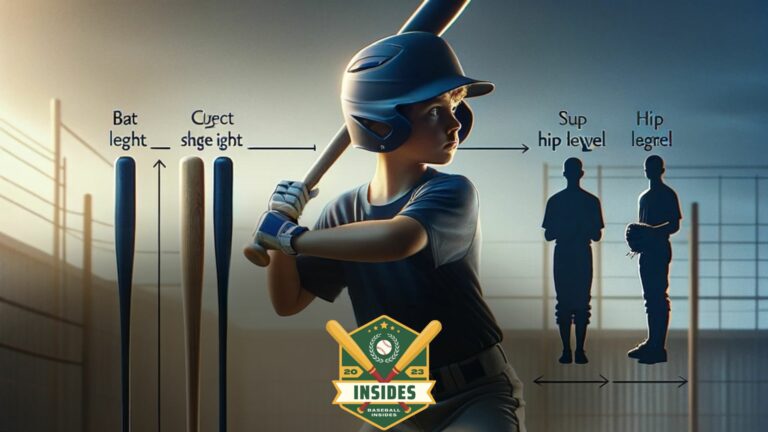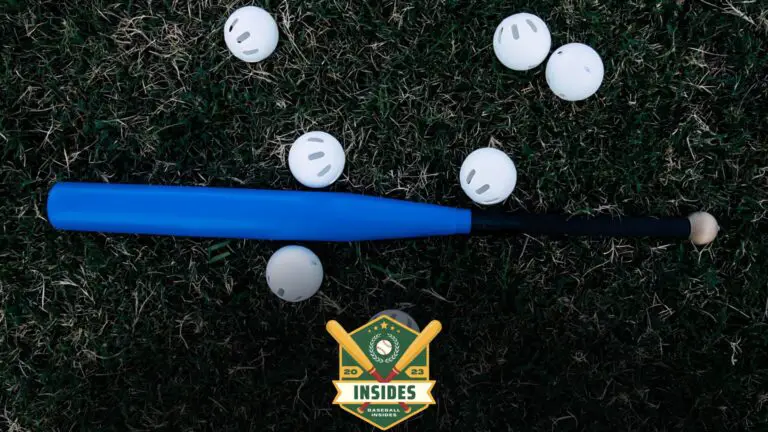
In this article:
Wood bats can break during any at-bat but typically last through 10-25 games. Factors like wood density and quality affect their longevity.
Wood bats are synonymous with traditional baseball and are admired for their aesthetic and performance. Crafted from various types of wood, each bat has a unique lifespan influenced by the material’s properties and the hitting style of the player.
Ensuring proper bat maintenance and understanding the mechanics of your swing can extend a bat’s usability.
High-quality wood bats, paired with proper hitting techniques, lead to fewer breaks and a better experience on the field.
Baseball enthusiasts and players must balance the authentic feel of wood bats with their inherent fragility when deciding on their bat of choice for season play.
Wood Bats in Baseball
Wood bats hold a special place in baseball tradition. They produce the iconic crack of the ball when hit just right.
Players of all ages, from little league to the majors, use wood bats. Knowing the lifespan of these bats is crucial for any player’s game.
Popularity and Historical Significance
The history of baseball intertwines with the evolution of wood bats. They were the only option for players in the early days. Legends like Babe Ruth and Ty Cobb crafted their careers swinging wood.
Today, wood bats are mandatory in professional leagues. This rule honors the game’s origins and challenges hitters to master their craft.
- Babe Ruth’s preference for heavy bats influenced many.
- Professional use maintains heritage and skill.
- Amateur players often practice with wood to improve their game.
Material Choices and Their Impact
Several wood types are used to create bats. Each type affects the bat’s performance and longevity. The most common are maple, ash, and hickory.
| Wood Type | Characteristics | Durability |
|---|---|---|
| Maple | Dense and hard | High |
| Ash | Flexible and tough | Medium |
| Hickory | Heavy and durable | Variable |
Maple bats are a top choice for pros. They’re sturdy. But they can also snap if hit on the wrong spot. Ash bats give a bit more. They might not break as suddenly.
Yet, they can splinter over time. Hickory, while historically popular, is now less common. It fell out of favor due to its weight.
Factors Leading to Breakage
Understanding what causes wood bats to break can help players and coaches make better choices. Factors such as grain orientation and the quality of the bat play a vital role in its durability.
Let’s explore these key elements that contribute to the lifespan of your wood bat.
Grain Orientation and Structure
How wood grains align in a bat is crucial for strength and resilience. A straight grain means a stronger bat. Here’s what you need to know:
- Parallel Grains: Reduce the chance of splintering.
- Tight Grains: Offer more durability than wider grains.
- Handle Thickness: Thinner handles may break more easily due to less support.
Manufacturing Defects and Quality
Not all bats are created equal. Poor manufacturing can lead to early breakage. Here are common defects to look out for:
- Inconsistencies in Wood Density: Can lead to uneven weight distribution.
- Improper Drying Processes: Causes the wood to be brittle and weak.
- Coating and Finishing Flaws: Affects the bat’s surface integrity.
Players should inspect bats for these issues before purchase to ensure they get a quality product.
Bat Durability and Maintenance
Wood bats bring a classic feel to the game of baseball. They can break under stress. Understanding bat durability is key.
Keeping your wood bat in top condition requires care. Let’s dive into how proper storage and routine maintenance can help.
Proper Storage Practices
Wood bats last longer with correct storage. Humidity and temperature changes affect wood. To avoid this:
- Keep bats indoors: Store them in a cool, dry place.
- Avoid moisture: Wet conditions lead to warping.
- Hang horizontally: This prevents bowing over time.
Do not leave bats in cars or trunks. Extreme heat or cold can damage them.
Routine Inspections and Care
Regular checks keep bats ready for action. Look for:
- Cracks or splits along the grain.
- Signs of wood weakness.
- The loose grain from repeated use.
Care includes:
- Cleaning: Wipe with a damp cloth and dry immediately.
- Sanding: Smooth out rough spots or splinters.
- Conditioning: Rubbing bat wax or oil preserves the wood.
Change tape or grip as needed. Inspect bats regularly, especially after a game.
Breaking Points of Wood Bats
The breaking of a wood bat is an event that can affect any level of baseball. Many factors contribute to the breaking of a wood bat, including the type of wood, the quality of the bat, and how it’s used.
In professional play, players pay close attention to these factors, knowing that the longevity of their bat is crucial to their performance at the plate.
Typical Lifespan in Professional Play
In professional baseball, the lifespan of a wood bat often depends on the number of quality at-bats and solid contact with the ball.
A well-crafted bat can last anywhere from a week to a month if used frequently during games and batting practice.
Batters inspect the bat regularly for chips and cracks to maintain its integrity.
Stress Points and Impact Scenarios
Wood bats face their toughest challenge upon the impact of a high-velocity fastball. The “sweet spot” area is the most resilient, while areas further up the barrel or closer to the handle are more prone to breakage.
If a pitch contacts the bat outside the sweet spot during a swing, the risk of breaking dramatically increases.
- Handle: Thin and vulnerable, a miss-hit here can result in a split bat.
- End of the barrel: Too much impact here can snap the wood.
- Edge grain hitting: Bat’s weakest part, breaking easily if struck.
| Part of Bat | Break Likelihood | Reason |
|---|---|---|
| Handle | High | Thin and prone to snapping |
| Barrel End | Medium | Can crack under pressure |
| Sweet Spot | Low | Designed for impact |
| Edge Grain | Very High | Easily splits on impact |
Ensuring proper bat selection and care is crucial to minimize the risk of a wood bat breaking.
A batter’s style, swing, and the quality of wood also play a vital role in the longevity of their equipment.
All wood bats have a breaking point; understanding these factors can help extend their life on the field.
Comparing Wood to Other Materials
In baseball and softball, bat material can greatly affect performance and durability. Players often debate over the best material for their bats.
Let’s compare wood bats with aluminum and composite counterparts and explore their performance trade-offs and preferences.
Wood Bats Versus Aluminum
- Wood bats, traditional and revered, can break more often than aluminum bats.
- Aluminum bats are tougher and rarely break but may dent over time.
Crafted from a single piece of timber, wood bats deliver a classic feel but must contend with the possibility of splintering upon impact.
Aluminum bats from metal alloys offer enduring strength and consistent performance.
Performance Trade-offs and Preferences
| Material | Performance | Preference |
|---|---|---|
| Wood | The ‘crack’ sound, natural feedback | Professional leagues |
| Aluminum/Composite | Less maintenance, longer lifespan | Amateur leagues, practice |
Players desiring a genuine game experience often lean towards wood bats. However, those seeking durability and less maintenance may prefer aluminum or composite bats.
Each material presents a distinct set of trade-offs that cater to different player preferences.
Advancements in Bat Technology
Wood bats have come a long way from the simple tools of the past. Their design and manufacturing techniques are at the forefront of sports equipment innovation.
Manufacturers focus on strength, durability, and performance. This progression means breakage is less frequent than ever.
Innovations in Wood Bat Design
The quest for the perfect wood bat has led to significant changes. New shaping methods prioritize the balance and grain alignment, enhancing overall strength.
- Dense wood selection – ensures durability.
- Improved tapering – reduces the chance of splintering upon impact.
- Refined handle design – offers better grip and reduced vibrations.
Future Trends in Bat Durability
Durability is key for tomorrow’s wood bats. Expect innovations like:
| Technology | Benefits |
|---|---|
| Smart fibers | Self-repairing micro-breaks |
| Nano treatments | Improving surface hardness |
| Hybrid materials | Combining wood with composites |
In summary, wood bat technology continuously evolves. These innovations extend lifespan and enhance playability, ensuring wood bats break less frequently.

Frequently Asked Questions
Is It Hard to Break a Wooden Bat?
Yes, breaking a wooden bat can be challenging due to its designed durability and the quality of wood used. Proper force or an improper hit can cause it to snap.
Do Wood Bats Have a Break in Period?
Wood bats do not require a break-in period. They are ready for use immediately upon purchase.
How Do You Prevent a Wood Bat From Breaking?
Store a wood bat in a cool, dry place and avoid extreme temperatures to prevent it from breaking. Always strike the ball with the bat’s labeled side. Regularly check for damage and apply linseed oil to maintain moisture levels. Use the bat within its recommended hitting range.
How Many Hits Can a Wooden Bat Take?
A wooden bat’s lifespan is not exact, as it depends on factors like wood quality and usage frequency, but typically, it can withstand between 100 to 1000 hits before cracking or breaking.
How Long Do Wood Bats Typically Last?
Wood bats generally last from a few weeks to a year, depending on usage intensity, wood quality, and maintenance.
Conclusion
Wrapping up, the lifespan of wood bats depends on factors like material, usage, and maintenance. Consistent care and proper handling can reduce breakage.
Players, from rookies to pros, can expect variability in bat durability. Remember these tips and choose wisely to ensure your bat stays in the game longer.






